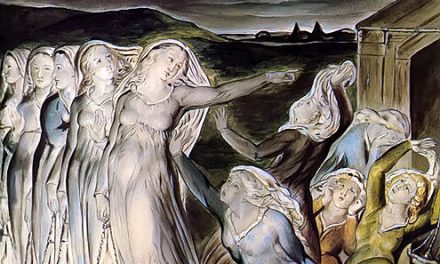This week, I’m headed down the road to Columbus to begin formation for Level III (ages 9-12) of Catechesis of the Good Shepherd (CGS). For those who don’t know, CGS is a Montessori-based catechetical model steeped in scripture and liturgy. One of its founders, Sophia Cavalletti was herself a scripture scholar in Rome when she began the program in 1953. She joined with Montessori teacher Gianna Gobbi, among others, to observe children in their encounters with God. Together, they found just those essential things that spoke developmentally to children – things like God is light and how small mustard seeds help the smallest Catholics among us think about the Kingdom of God. They created child-sized altar areas where children could learn the names of the objects at the mass, and built dioramas for teaching infancy narratives. They developed 3D maps of Israel and the City of Jerusalem for helping children learn about Jesus’ space and time – things that, frankly, I didn’t learn myself till I was well in grad school.
It’s an attractive program and has spread throughout the world. It has an ecumenical reach – Catholics, liturgically-minded Protestants, and Orthodox have all been touched by CGS. CGS requires adult catechists to go through a pretty extensive formation program – 90-100 hours for both Level I (3-6 year olds) and Level II (6-9 year olds). Those hundred hours include theological training, seeing how to make presentations of the materials, observing Montessori and CGS classrooms both, as well as personal spiritual formation.
Obviously, this work has touched me. I began it back in my grad school days and I credit working with CGS kids as part of the reason I remained sane during grad school. Fast forward many years: I’ve surprised even myself by starting a program from scratch at my parish for ages 3-6 and 6-9, that now has 8 trained catechists. Now I’m looking forward to adding ages 9-12.
Of course CGS touches my work as a moral theologian. Here are just three of some of the many take aways I’ve learned over the years.
- Faith can’t be bought and sold – but sometimes it looks like it can. It’s both true and important that CGS can’t be bottled or boxed up, or booked up, and sold. I think a consumer culture like ours has trained all of us – including me – to think that I can buy an ethos. Why do I so often try to grab a memento when I’m on retreat or on vacation? I want the sense of peace, holiness, relaxation that the place offers – and I think I fall into believing a memento can help with that.
I also think that subconciously I have in mind that if I can buy the right ethos, then I’m doing the right thing and I’m on the right path. Moral life isn’t that easy, though. You can’t buy your way to it- not even through the perfect-looking pristine living rooms in catalogues and carefully curated boxes of organic vegetables that form middle classes images of the “right” life. I think sometimes we fall into thinking we can similarly buy perfection in the form of the perfect curriculum or just the right kind of new-fashioned Bible or cross.
CGS pushes against that consumer mindset in its formation classes. You can’t learn this stuff from a book – you get it from someone else who learned it from someone else, who may well have learned it from Sophia Cavalletti. And while you can buy the materials – you’re encouraged to hand make them. Even if you do buy them, you’re buying the unfinished cut wood, the unfinished paper. There’s still work to be done in sanding, painting, coloring, laminating and making the materials yours. That’s because in making the materials, you, too, learn a bit about CGS’s particular ethos.
In having to painstakingly make materials and sit in formation classes, you begin to be the kind of person who can patiently observe children in the atrium and allow them to respond to God in their own way and time – (Rather than being the kind of person who believes she has all the right answers and storms in to take over). You begin to be a person who can comfortably inhabit silence and do purposeful work with joy.
Especially importantly, you being to learn you can’t do this all on your own. You learn CGS in a community of other people, some of whom are better than you are. You learn that some of the people you’re learning from are quite a bit younger than you are – 2 or 3 years old in fact – but yet might be speaking something truthful to you about God.
That kind of communal effort and formation in CGS is probably the most crucial point I’ve learned in relation to my work as a moral theologian. Practicing virtue, learning the kind of habits and patterns of thought God wants – and trying to live counterculturally – these are some of the most difficult aspects of moral theology.
2. God is present to us and in us. Most of the time we don’t see that, and consequently we have as hard a time believing it as Thomas had a hard time believing in the risen Lord.
One of CGS’s basic tenets is that catechists are like the “worthless servant” who simply needs to be doing what we were asked to do. We present the materials God has gifted us with – the scriptures and the mass – and then we step out of the way.
We let God and God’s relationship with each particular child matter more than whatever important words we thought we were going to say.
That’s hard for an academic to learn, but equally true for the context of moral theology. God is present here, but I so often don’t act as though I believe that. God acts – even in the apparently ungrateful 20-somethings, and yes, in the journal articles and books we read and write.
3. Making mistakes is important for a robust life of faith.
The thing about learning CGS in community is that we learn it messily and imperfectly. When I go back and look at my notes on how to present a synthesis of mass gestures to children preparing for first communion, I have no idea what anyone was trying to say. So I go back through the readings, go back through the notes, remember the essential point – God will work in these children – and hope that I, too, will learn something today.
Children in my atrium have the freedom to make mistakes – and I am learning I have freedom for that to. In making those mistakes, I find that in fact I am learning to come closer to God.
I’m not going to get it right or do it right the first time. Heavens, I’m probably still going to have a lot to learn when I’m sitting with children telling the story of the mustard seed for the hundredth time.
I think that moral life is best enabled if we are able to admit errors, learn from them, and keep growing. That’s the best meaning of the sacrament of reconciliation to me, in fact. Maria Montessori often spoke about the importance of the mistake – which runs quite counter to our cultural ideal of never making mistakes at all.
Yet I think moral life is actually opened up quite a bit when we accept the givenness of God and the possibilities that lie in our own human imperfection.





